Effect of Toxoplasma gondii on Ram Sperm Quality after Experimental Infection
Abstract
1. Introduction
2. Results
2.1. Clinical Findings
2.2. Serology
2.3. Molecular Analysis
2.4. Sperm Quality Parameters
2.4.1. Concentration
2.4.2. Viability
2.4.3. Sperm Morphology
2.4.4. Motility and Kinetics
2.4.5. Hypo-Osmotic Swelling Test (HOS-Test), Sperm Membrane Biochemical Functionality
2.4.6. Sperm DNA Integrity
2.5. Histopathological Findings
3. Discussion
4. Materials and Methods
4.1. Toxoplasma gondii Strain and Inoculation
4.2. Experimental Design, Animals
4.3. Clinical Examination
4.4. Serological Analysis
4.5. Molecular Analysis
4.6. Epididymal Sperm Samples Collection
4.7. Sperm Evaluation
4.7.1. Concentration
4.7.2. Sperm Viability and Morphology Assessment
4.7.3. Computer-Assisted Sperm Motility and Kinetics Analysis
4.7.4. Sperm Membrane Biochemical Functionality
4.7.5. Sperm DNA Integrity
4.8. Histopathological Examination
4.9. Statistical Analysis
4.10. Ethics Statement
5. Conclusions
Author Contributions
Funding
Acknowledgments
Conflicts of Interest
References
- Dubey, J.P. Toxoplasmosis of Animals and Humans, 2nd ed.; CRC Press Taylor & Francis Group: Boca Raton, FL, USA, 2010; ISBN 9780429092954. [Google Scholar]
- Tenter, A.M.; Heckeroth, A.R.; Weiss, L.M. Toxoplasma gondii: From animals to humans. Int. J. Parasitol. 2000, 30, 1217–1258. [Google Scholar] [CrossRef]
- Dubey, J.P.; Jones, J.L. Toxoplasma gondii infection in humans and animals in the United States. Int. J. Parasitol. 2008, 38, 1257–1278. [Google Scholar] [CrossRef] [PubMed]
- Buxton, D.; Maley, S.W.; Wright, S.E.; Rodger, S.; Bartley, P.; Innes, E.A. Toxoplasma gondii and ovine toxoplasmosis: New aspects of an old story. Vet. Parasitol. 2007, 149, 25–28. [Google Scholar] [CrossRef] [PubMed]
- Moura, A.B.; Costa, A.J.; Filho, S.J.; Paim, B.B.; Pinto, F.R.; Di Mauro, D.C. Toxoplasma gondii in semen of experimentally infected swine. Pesqui. Veterinária Bras. 2007, 27, 430–434. [Google Scholar] [CrossRef][Green Version]
- Lopes, W.D.Z.; Da Costa, A.J.; Santana, L.F.; dos Santos, R.S.; Rossanesse, W.M.; Lopes, W.C.Z.; Costa, G.H.N.; Sakamoto, C.A.; dos Santos, T.R. Aspects of Toxoplasma infection on the reproductive system of experimentally infected rams (Ovis aries). J. Parasitol. Res. 2009, 602803:1–602803:6. [Google Scholar] [CrossRef] [PubMed]
- Santana, L.F.; da Costa, A.J.; Pieroni, J.; Lopes, W.D.Z.; Santos, R.S.; de Oliveira, G.P.; de Mendonça, R.P.; Sakamoto, C.A.M. Detection of Toxoplasma gondii in the reproductive system of male goats. Rev. Braz. Parasitol. Vet. 2010, 19, 179–182. [Google Scholar] [CrossRef] [PubMed]
- Teale, A.J.; Blewett, D.A.; Miller, J.K. Experimentally induced toxoplasmosis in young rams: The clinical syndrome and semen secretion of toxoplasma. Vet. Rec. 1982, 111, 53–55. [Google Scholar] [CrossRef]
- Bezerra, M.J.G.; Cruz, J.A.L.O.; Kung, E.S.; Albuquerque, P.P.F.; Kim, P.C.P.; Moraes, E.P.B.X.; Pinheiro, J.J.W.; Mota, R.A. Detection of Toxoplasma gondii DNA in fresh and frozen semen from rams in Brazil. Reprod. Domest. Anim. 2014, 49, 753–755. [Google Scholar] [CrossRef]
- De Oliveira Koch, M.; Dittrich, R.L.; Weiss, R.R.; Bergstein-Galan, T.; Aguiar, D.M.; Brandão, Y.O.; Cruz, A.A.; Busch, A.P.B.; Monteiro, A.L.G. Detection of Neospora caninum and Toxoplasma gondii in Semen of Naturally Infected Rams. Acta Sci. Vet. 2019, 47, 1656:1–1656:8. [Google Scholar] [CrossRef]
- Rouatbi, M.; Amairia, S.; Lahmer, M.; Lassoued, N.; Rekik, M.; Wieland, B.; Mwacharo, J.M.; Gharbi, M. Detection of Toxoplasma gondii infection in semen of rams used for natural mating in commercial sheep farms in Tunisia. Vet. Parasitol. Reg. Stud. Rep. 2019, 18, 100341:1–100341:6. [Google Scholar] [CrossRef]
- Lopes, W.D.Ζ.; Rodriguez, J.D.; Souza, F.A.; dos Santos, T.R.; dos Santos, R.S.; Rosanese, W.M.; Lopes, W.R.Z.; Sakamoto, C.A.; da Costa, A.J. Sexual transmission of Toxoplasma gondii in sheep. Vet. Parasitol. 2013, 195, 47–56. [Google Scholar] [CrossRef] [PubMed]
- Santana, L.F.; Rossi, G.A.M.; Gaspar, R.C.; Pinto, V.M.R.; de Oliveira, G.P.; da Costa, A.J. Evidence of sexual transmission of Toxoplasma gondii in goats. Small Rumin. Res. 2013, 115, 130–133. [Google Scholar] [CrossRef]
- De Moraes, E.P.B.X.; Batista, A.M.; Faria, E.B.; Freire, R.L.; Freitas, A.C.; Silva, M.A.R.; Braga, V.A.; Mota, R.A. Experimental infection by Toxoplasma gondii using contaminated semen containing different doses of tachyzoites in sheep. Vet. Parasitol. 2010, 170, 318–322. [Google Scholar] [CrossRef] [PubMed]
- Consalter, A.; Silva, A.F.; Frazão–Texeira, E.; Matos, L.F.; de Oliveira, F.C.R.; Leite, J.S.; Silva, F.B.F.; Ferreira, A.M.R. Toxoplasma gondii transmission by artificial insemination in sheep with experimentally contaminated frozen semen. Theriogenology 2017, 90, 169–174. [Google Scholar] [CrossRef] [PubMed]
- Tsakmakidis, I.A.; Lymberopoulos, A.G.; Khalifa, T.A. Relationship between sperm quality traits and field-fertility of porcine semen. J. Vet. Sci. 2010, 11, 151–154. [Google Scholar] [CrossRef] [PubMed]
- Carel, J.C.; Lahlou, N.; Roger, M.; Chaussain, J.L. Precocious puberty and statural growth. Hum. Reprod. Update 2004, 10, 135–147. [Google Scholar] [CrossRef] [PubMed]
- Terpsidis, K.I.; Papazahariadou, M.G.; Taitzoglou, I.A.; Papaioannou, N.G.; Georgiadis, M.P.; Theodoridis, I.T. Toxoplasma gondii: Reproductive parameters in experimentally infected male rats. Exp. Parasitol. 2009, 121, 238–241. [Google Scholar] [CrossRef]
- Arantes, T.P.; Lopes, W.D.Z.; Ferreiram, R.M.; Pieronim, J.P.; Pintom, V.M.R.; Santos, T.R.; Sakamoto, C.A.; Da Costa, A.J. Histopathological analysis of the reproductive system of male dogs experimentally infected with Toxoplasma gondii. Ciensia Rural 2009, 39, 2123–2127. [Google Scholar] [CrossRef]
- De Moura, A.B.; Filho, S.J.; Di Mauro, D.C.; Paim, B.B.; Pinto, F.R.; da Costa, A.J. Evaluation of semen parameters of boars (Sus scrofa) experimentally infected with Toxoplasma gondii. Semin. Ciências Agrárias 2004, 25, 107–116. [Google Scholar] [CrossRef]
- Lopes, W.D.Z.; Costa, A.J.; Souza, F.A.; Rodrigues, J.D.F.; Costa, G.H.N.; Soares, V.E.; Silva, G.S. Semen variables of sheep (Ovis aries) experimentally infected with Toxoplasma gondii. Anim. Reprod. Sci. 2009, 111, 312–319. [Google Scholar] [CrossRef]
- Buxton, D.; Blewett, D.A.; Trees, A.J.; McColgan, C.; Finlayson, J. Further studies in the use of monensin in the control of experimental ovine toxoplasmosis. J. Comp. Pathol. 1988, 98, 225–236. [Google Scholar] [CrossRef]
- Giadinis, N.D.; Terpsidis, K.; Diakou, A.; Siatkou, V.; Loukopoulos, P.; Osman, R.; Karatzias, H.; Papazahariadou, M. Massive Toxoplasma abortions in a dairy sheep flock and therapeutic approach with different doses of sulfadimidine. Turk. J. Vet. Anim. Sci. 2011, 35, 207–211. [Google Scholar] [CrossRef]
- Giadinis, N.D.; Lafi, S.Q.; Ioannidou, E.; Papadopoulos, E.; Terpsidis, K.; Karanikolas, G.; Petridou, E.J.; Brozos, C.; Karatzias, H. Reduction of the abortion rate due to Toxoplasma in 3 goat herds following administration of sulfadimidine. Can. Vet. J. 2013, 54, 1080–1082. [Google Scholar] [PubMed]
- Buxton, D.; Thomson, K.M.; Maley, S. Treatment of ovine toxoplasmosis with a combination of sulphamezathine and pyrimethamine. Vet. Rec. 1993, 132, 409–411. [Google Scholar] [CrossRef] [PubMed]
- Dubey, J.P.; Sharma, S.P. Prolonged excretion of Toxoplasma gondii in semen of goats. Am. J. Vet. Res. 1980, 41, 794–795. [Google Scholar]
- McColgan, C.; Buxton, D.; Blewett, D.A. Titration of Toxoplasma gondii oocysts in non-pregnant sheep and the effects of subsequent challenge during pregnancy. Vet. Rec. 1988, 123, 467–470. [Google Scholar] [CrossRef] [PubMed]
- Esteban–Redondo, I.; Innes, E.A. Detection of Toxoplasma gondii in tissues of sheep orally challenged with different doses of oocysts. Int. J. Parasitol. 1998, 28, 1459–1466. [Google Scholar] [CrossRef]
- Esteban–Redondo, I.; Maley, S.W.; Thomson, K.; Nicoll, S.; Wright, S.; Buxton, D.; Innes, E.A. Detection of T. gondii in tissues of sheep and cattle following oral infection. Vet. Parasitol. 1999, 86, 155–171. [Google Scholar] [CrossRef]
- Kul, O.; Yildiz, K.; Ocal, N.; Freyre, A.; Deniz, A.; Karahan, S.; Atmaca, H.T.; Gokpinar, S.; Dincel, G.C.; Uzunalioglu, T.; et al. In-vivo efficacy of toltrazuril on experimentally induced Toxoplasma gondii tissue cysts in lambs: A novel strategy for prevention of human exposure to meat-borne toxoplasmosis. Res. Vet. Sci. 2013, 94, 269–276. [Google Scholar] [CrossRef]
- Cheng, C.Y.; Mruk, D.D. The blood-testis barrier and its implications for male contraception. Pharmacol. Rev. 2012, 64, 16–64. [Google Scholar] [CrossRef]
- Arantes, T.P.; Lopes, W.D.Z.; Ferreira, R.M.; Pieroni, J.P.; Pinto, V.M.R.; Santos, T.R.; Sakamoto, C.A.; da Costa, A.J. Toxoplasma gondii: Evidence for the transmission by semen in dogs. Exp. Parasitol. 2009, 132, 190–194. [Google Scholar] [CrossRef]
- Scarpelli, L.; Lopes, W.D.Z.; Migani, M.; Bresciani, K.D.S.; da Costa, A.J. Toxoplasma gondii in experimentally infected Bos taurus and Bos indicus semen and tissues. Pesqui. Veterinária Bras. 2009, 29, 59–64. [Google Scholar] [CrossRef]
- Glor, S.B.; Edelhofer, R.; Grimm, F.; Deplazes, P.; Basso, W. Evaluation of a commercial ELISA kit for detection of antibodies against Toxoplasma gondii in serum, plasma and meat juice from experimentally and naturally infected sheep. Parasites Vectors 2013, 6, 85:1–85:11. [Google Scholar] [CrossRef] [PubMed]
- Aquizerate, F.; Cazenave, J.; Poirier, L.; Verin, P.H.; Cheyrou, A.; Begueret, J.; Lagoutte, F. Detection of Toxoplasma gondii in aqueous humour by the polymerase chain reaction. Br. J. Ophthalmol. 1993, 77, 107–109. [Google Scholar] [CrossRef] [PubMed][Green Version]
- World Health Organization, Department of Reproductive Health and Research. WHO Laboratory Manual for the Examination and Processing of Human Semen, 5th ed.; WHO Press: Geneva, Switzerland, 2010; ISBN 9789241547789. [Google Scholar]
- Sun, L.H.; Fan, F.; Wang, J.J.; Gong, J. Acute Toxoplasma gondii infection affects the reproductive function of male mice. Zhonghua Nan Ke Xue 2008, 14, 55–57. [Google Scholar] [PubMed]
- Abdoli, A.; Dalimi, A.; Movahedin, M. Impaired reproductive function of male rats infected with Toxoplasma gondii. Andrologia 2012, 44, 679–687. [Google Scholar] [CrossRef] [PubMed]
- Stahl, W.; Kaneda, Y.; Noguchi, T. Reproductive failure in mice chronically infected with Toxoplasma gondii. Parasitol. Res. 1994, 80, 22–28. [Google Scholar] [CrossRef]
- Antonios, S.N.; Ismail, H.I.; Essa, T. Hypothalamic origin of reproductive failure in chronic experimental toxoplasmosis. J. Egypt. Soc. Parasitol. 2000, 30, 593–599. [Google Scholar] [PubMed]
- Dalimi, A.; Abdoli, A. Toxoplasma gondii and male reproduction impairment: A new aspect of Toxoplasmosis research. Jundishapur J. Microbiol. 2013, 6, e7184:1–e7184:5. [Google Scholar] [CrossRef]
- Dvorakova–Hortova, K.; Sidlova, A.; Ded, L.; Hladovcova, D.; Vieweg, M.; Weidner, W.; Steger, K.; Stopka, P.; Paradowska-Dogan, A. Toxoplasma gondii decreases the reproductive fitness in mice. PLoS ONE 2014, 9, e96770:1–e96770:11. [Google Scholar] [CrossRef]
- O’Hara, L.; Hanrahan, J.P.; Richardson, L.; Donovan, A.; Fair, S.; Evans, A.C.O.; Lonergan, P. Effect of storage duration, storage temperature, and diluent on the viability and fertility of fresh ram sperm. Theriogenology 2010, 73, 541–549. [Google Scholar] [CrossRef] [PubMed]
- Vicente–Fiel, S.; Palacín, I.; Santolaria, J.P.; Fantova, E.; Quintín-Casorrán, F.J.; Sevilla-Mur, E.; Yániz, J.L. In vitro assessment of sperm quality from rams of high and low field fertility. Anim. Reprod. Sci. 2014, 146, 15–20. [Google Scholar] [CrossRef] [PubMed]
- Santolaria, P.; Vicente–Fiel, S.; Palacín, I.; Fantova, E.; Blasco, M.E.; Silvestre, M.A.; Yániz, J.L. Predictive capacity of sperm quality parameters and sperm subpopulations on field fertility after artificial insemination in sheep. Anim. Reprod. Sci. 2015, 163, 82–88. [Google Scholar] [CrossRef] [PubMed]
- Del Olmo, E.; García–Álvarez, O.; Maroto–Morales, A.; Ramón, M.; Jiménez–Rabadán, P.; Iniesta–Cuerda, M.; Anel–Lopez, L.; Martinez–Pastor, F.; Soler, A.J.; Garde, J.J.; et al. Estrous sheep serum enables in vitro capacitation of ram spermatozoa while preventing caspase activation. Theriogenology 2016, 85, 351–360. [Google Scholar] [CrossRef]
- Fernández Abella, D.F.; Da Costa, M.; Guérin, Y.; Dacheux, J.L. Fertility of undiluted ram epididymal spermatozoa stored for several days at 4 °C. Animal 2015, 9, 313–319. [Google Scholar] [CrossRef]
- Phillips, N.J.; Mcgowan, M.R.; Johnston, S.D.; Mayer, D.G. Relationship between thirty post-thaw spermatozoa characteristics and the field fertility of 11 high-use Australian dairy AI sires. Anim. Reprod. Sci. 2004, 81, 47–61. [Google Scholar] [CrossRef]
- Hoflack, G.; Opsomer, G.; Van Soom, A.; Maes, D.; De Kruif, A.; Duchateau, L. Comparison of sperm quality of Belgian Blue and Holstein Friesian bulls. Theriogenology 2006, 66, 1834–1846. [Google Scholar] [CrossRef]
- Hulet, C.V.; Foote, W.C.; Blackwell, R.L. Relationship of semen quality and fertility in the ram to fecundity in the ewe. J. Reprod. Fertil. 1965, 9, 311–315. [Google Scholar] [CrossRef][Green Version]
- Farrell, P.B.; Presicce, G.A.; Brockett, C.C.; Foote, R.H. Quantification of bull sperm characteristics by computer-assisted sperm analysis (CASA) and the relationship to fertility. Theriogenology 1998, 49, 871–879. [Google Scholar] [CrossRef]
- Tsakmakidis, I.A. Ram semen evaluation: Development and efficiency of modern techniques. Small Rumin. Res. 2010, 92, 126–130. [Google Scholar] [CrossRef]
- Michos, I.A.; Basioura, A.G.; Boscos, C.M.; Tsakmakidis, I.A. Proper use and impact of ‘Computer Assisted Semen Analysis’ technique on semen evaluation of farm animals. J. Hell. Vet. Med. Soc. 2013, 64, 267–274. [Google Scholar] [CrossRef][Green Version]
- Robayo, I.; Montenegro, V.; Valdés, C.; Cox, J.F. CASA assessment of kinematic parameters of ram spermatozoa and their relationship to migration efficiency in ruminant cervical mucus. Reprod. Domest. Anim. 2008, 43, 393–399. [Google Scholar] [CrossRef] [PubMed]
- Herrara, C.; Brogliatti, G.; Cavia, R.; Conde, P.; Revora, M.; Pasqualini, R.S. CASA sperm parameters and their relation with in vitro fertilization. In Proceedings of the 15th International Congress on Animal Reproduction, Porto Seguro, Brazil, 8–12 August 2004; Volume 2, pp. 411–415. [Google Scholar]
- Lodhi, L.A.; Zubair, M.; Qureshi, Z.I.; Ahmad, I.; Jamil, H. Correlation between hypo-osmotic swelling test and various conventional semen evaluation parameters in fresh Nili–Ravi buffalo and Sahiwal cow bull semen. Pak. Vet. J. 2008, 28, 186–188. [Google Scholar]
- Correa, J.R.; Pace, M.M.; Zavos, P.M. Relationship among frozen-thawed sperm characteristics assessed via the routine semen analysis, sperm functional tests and fertility of bulls in an artificial insemination program. Theriogenology 1997, 48, 721–731. [Google Scholar] [CrossRef]
- Kasimanickam, R.; Nebel, R.L.; Peeler, I.D.; Silvia, W.L.; Wolf, K.T.; McAllister, A.J.; Cassell, B.G. Breed differences in competitive indices of Holstein and Jersey bulls and their association with sperm DNA fragmentation index and plasma membrane integrity. Theriogenology 2006, 66, 1307–1315. [Google Scholar] [CrossRef] [PubMed]
- Silva, P.F.N.; Gadella, B.M. Detection of damage in mammalian sperm cells. Theriogenology 2006, 65, 958–978. [Google Scholar] [CrossRef]
- Barth, A.D.; Oko, R.J. Abnormal Morphology of Bovine Spermatozoa, 1st ed.; Iowa State University Press: Ames, IA, USA, 1989; ISBN 0813801125. [Google Scholar]
- Fusco, G.; Rinaldi, L.; Guarino, A.; Proroga, Y.T.R.; Pesce, A.; Giuseppina, M.; Cringoli, G. Toxoplasma gondii in sheep from the Campania region (Italy). Vet. Parasitol. 2007, 149, 271–274. [Google Scholar] [CrossRef]
- Halová, D.; Mulcahy, G.; Rafter, P.; Turčeková, L.; Grant, T.; De Waal, T. Toxoplasma gondii in Ireland: Seroprevalence and novel molecular detection method in sheep, pigs, deer and chickens. Zoonoses Public Health 2013, 60, 168–173. [Google Scholar] [CrossRef]
- Opsteegh, M.; Teunis, P.; Mensink, M.; Züchner, L.; Titilincu, A.; Langelaar, M.; van der Giessen, J. Evaluation of ELISA test characteristics and estimation of Toxoplasma gondii seroprevalence in Dutch sheep using mixture models. Prev. Vet. Med. 2010, 96, 232–240. [Google Scholar] [CrossRef]
- Fuentes, I.; Rodriguez, M.; Domingo, C.J.; Del Castillo, F.; Juncosa, T.; Alvar, J. Urine sample used for congenital toxoplasmosis diagnosis by PCR. J. Clin. Microbiol. 1996, 34, 2368–2371. [Google Scholar] [CrossRef]
- Boughattas, S.; Ayari, K.; Tongmin, S.; Aoun, K.; Bouratbine, A. Survey of the parasite Toxoplasma gondii in human consumed ovine meat in Tunis City. PLoS ONE 2014, 9, e85044:1–e85044:5. [Google Scholar] [CrossRef] [PubMed]
- Fournier–Delpech, S.; Colas, G.; Courot, M.; Ortavant, R.; Brice, G. Epididymal sperm maturation in the ram: Motility, fertilizing ability and embryonic survival after uterine artificial insemination in the ewe. Ann. Biol. Anim. Biochim. Biophys. 1979, 19, 560–597. [Google Scholar] [CrossRef]
- Dacheux, J.L.; Dacheux, F. New insights into epididymal function in relation to sperm maturation. Reproduction 2014, 147, 27–42. [Google Scholar] [CrossRef] [PubMed]
- Martinez–Pastor, F.; Garcia-Macias, V.; Alvarez, M..; Chamorro, C.; Herraez, P.; de Paz, P.; Anel, L. Comparison of two methods for obtaining spermatozoa from the cauda epididymis of Iberian red deer. Theriogenology 2006, 65, 471–485. [Google Scholar] [CrossRef] [PubMed]
- Soler, A.J.; Garde, J.J. Relationship between the characteristics of epididymal red deer spermatozoa and penetrability into zona-free hamster ova. J. Androl. 2003, 24, 393–400. [Google Scholar] [CrossRef]
- Kaabi, M.; Paz, P.; Alvarez, M.; Anel, E.; Boixo, J.C.; Rouissi, H.; Herraez, P.; Anel, L. Effect of epididymis handling conditions on the quality of ram spermatozoa recovered post-mortem. Theriogenology 2003, 60, 1249–1259. [Google Scholar] [CrossRef]
- Ntemka, A.; Kiossis, E.; Boscos, C.; Theodoridis, A.; Kourousekos, G.; Tsakmakidis, I. Effects of testicular hemodynamic and echogenicity changes on ram semen characteristics. Reprod. Domest. Anim. 2018, 53, 50–55. [Google Scholar] [CrossRef]
- Blom, E. Pathological conditions in the genital organs and in the semen as grounds for rejection of breeding bulls for import and export to or from Denmark. Nord. Vet. 1983, 35, 105–130. [Google Scholar]
- Pelufo, V.; López Armengol, M.F.; Malcotti, V.; Venturino, A.; Aisen, E.G. Effects of glycerol and sugar mixing temperature on the morphologic and functional integrity of cryopreserved ram sperm. Theriogenology 2015, 83, 144–151. [Google Scholar] [CrossRef]
- Tsakmakidis, I.A.; Lymberopoulos, A.G.; Khalifa, T.A.; Boscos, C.M.; Saratsi, A.; Alexopoulos, C. Evaluation of zearalenone and α-zearalenol toxicity on boar sperm DNA integrity. J. Appl. Toxicol. 2008, 28, 681–688. [Google Scholar] [CrossRef]
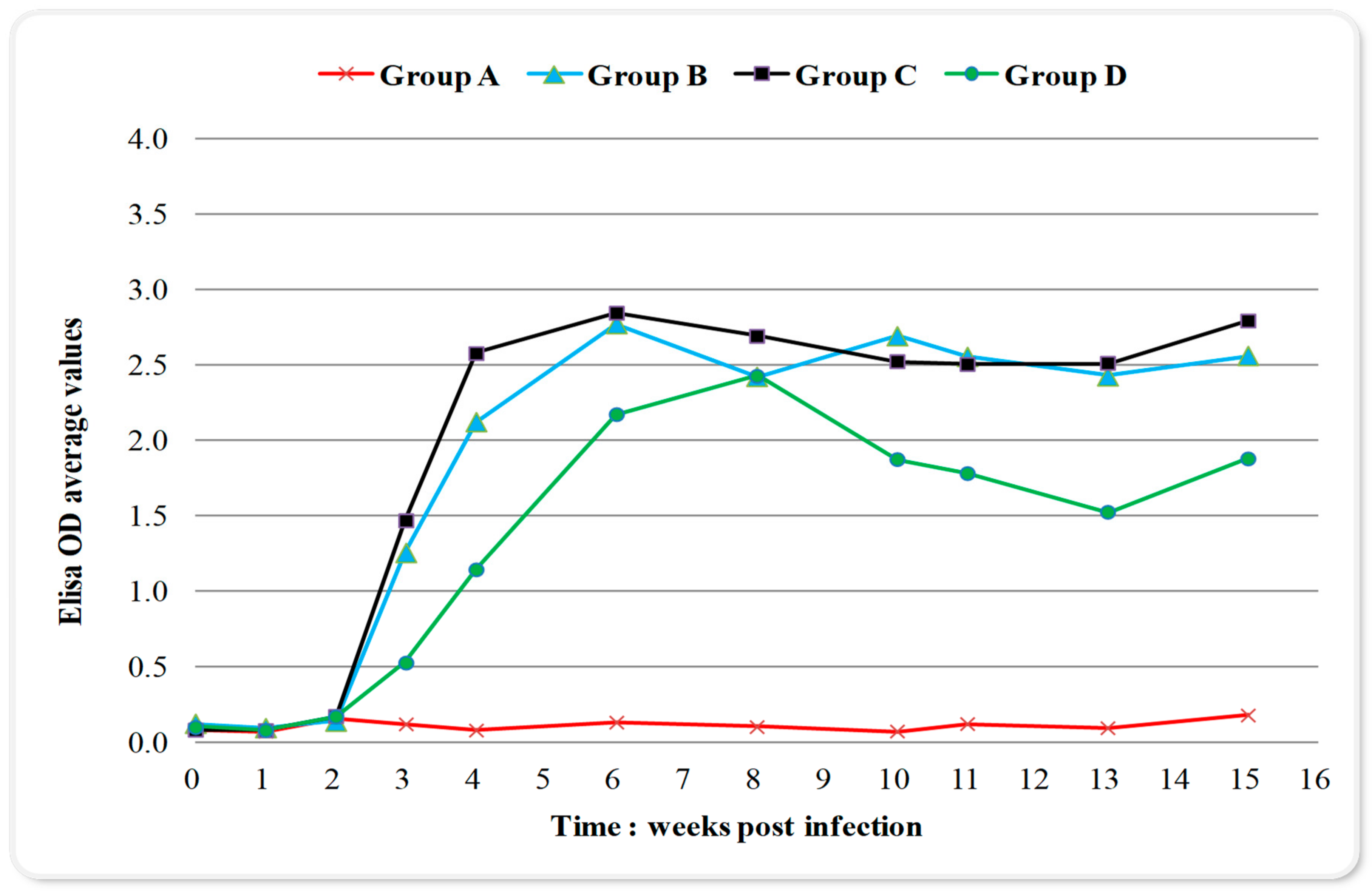

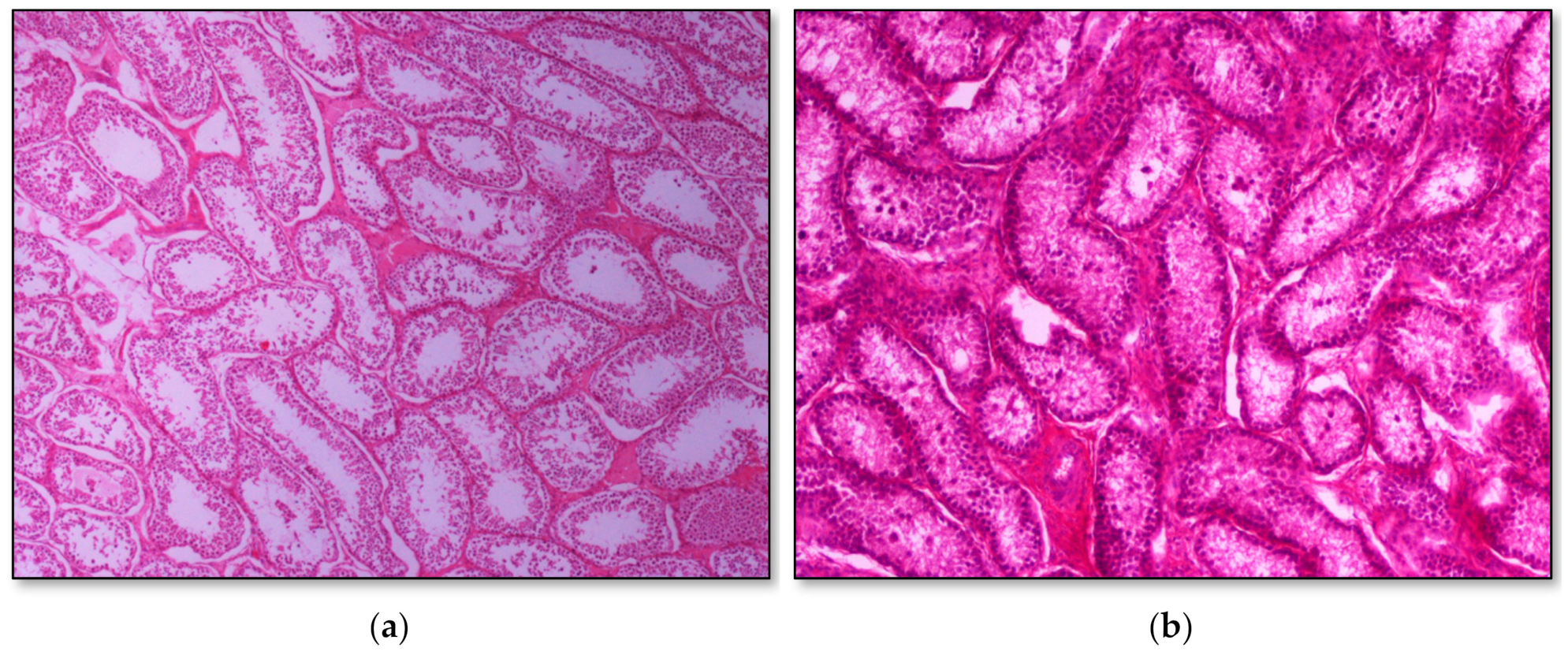
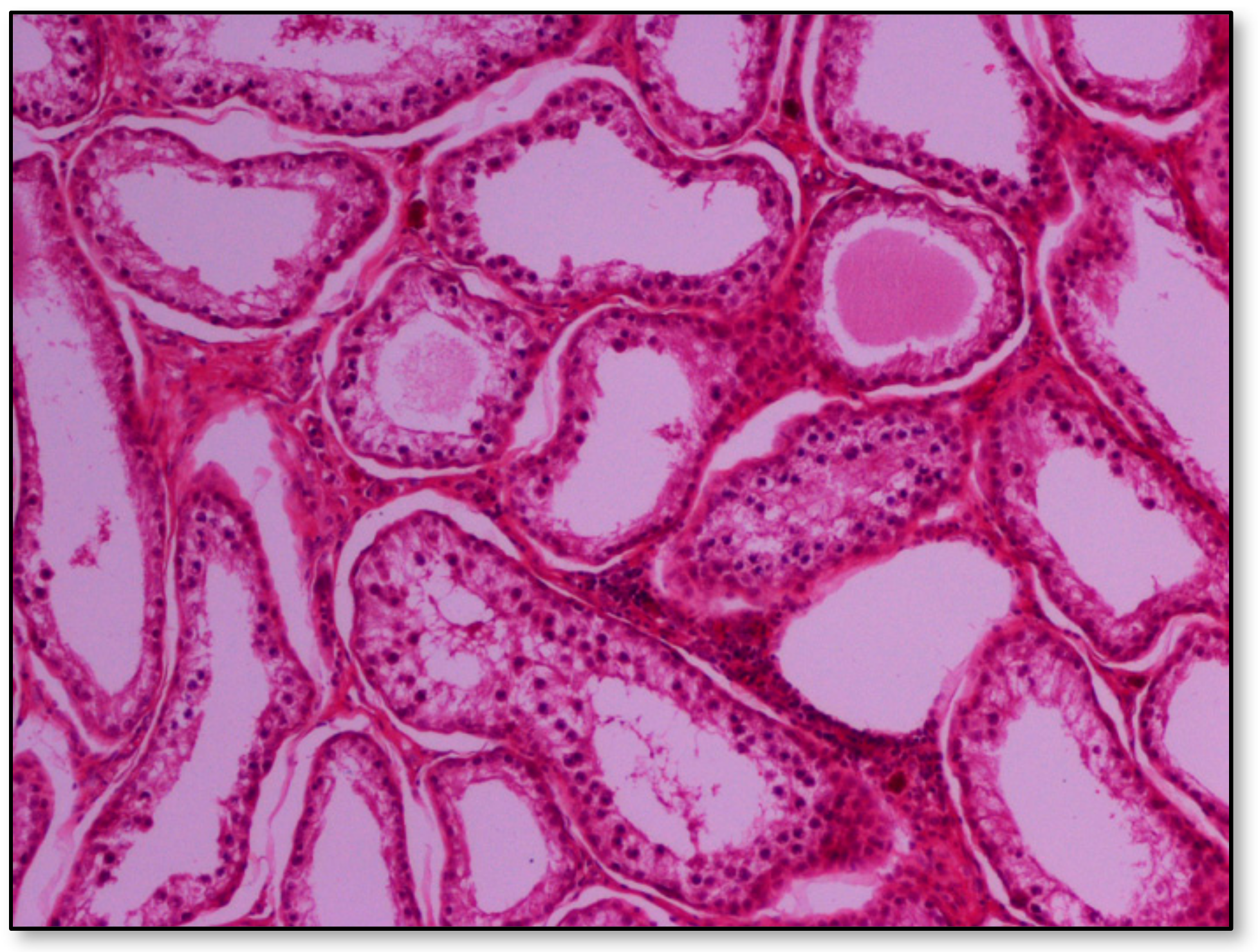


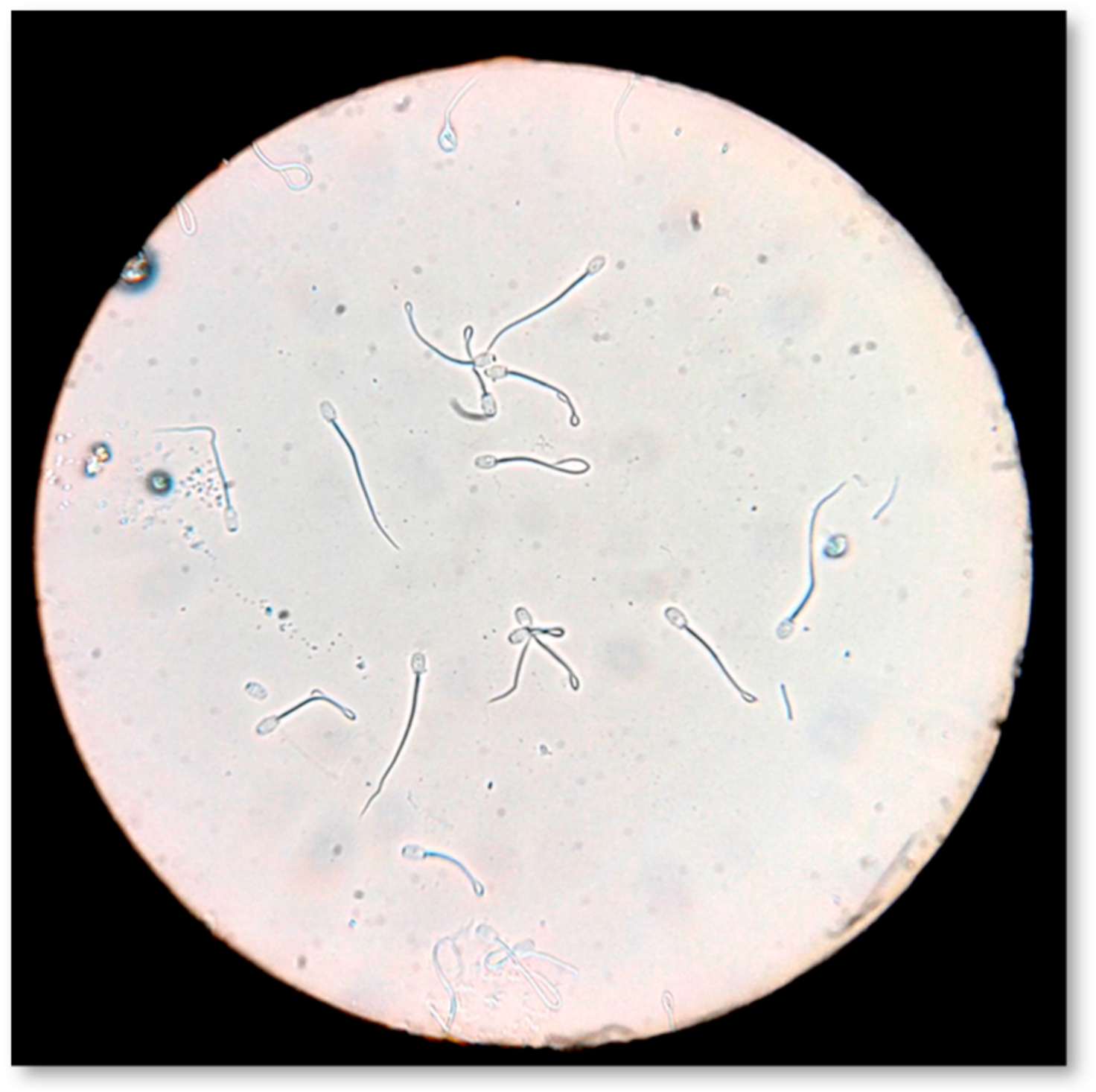
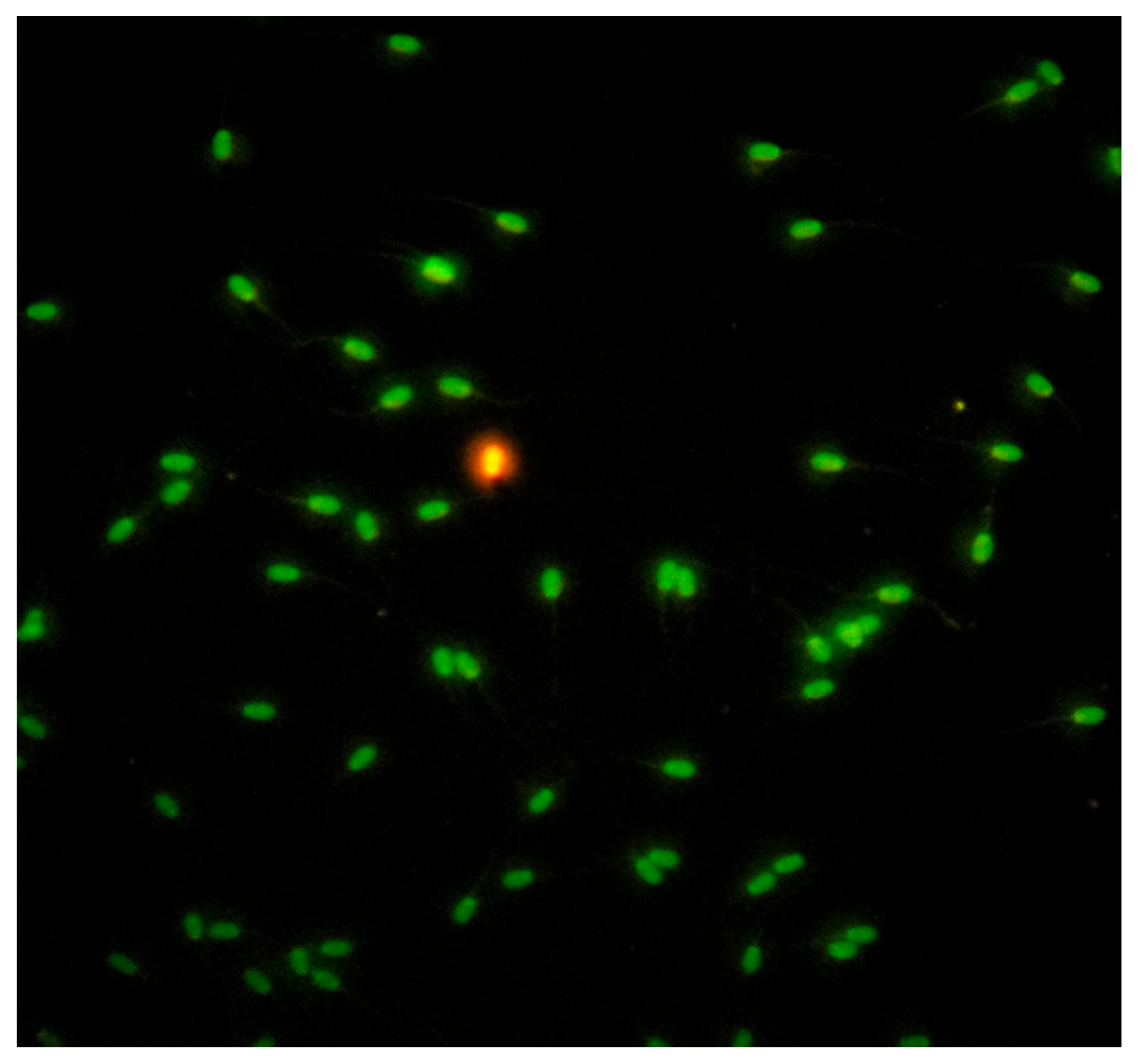
| Weeks of Blood Sampling | Optical Density Values—ELISA |
|---|---|
| 0 | 0.09 ± 0.05 a,b (0.0008) |
| 1 | 0.08 ± 0.03 a (0.007) |
| 2 | 0.15 ± 0.09 b (0.018) |
| 3 | 0.88 ± 0.70 c (0.085) |
| 4 | 1.55 ± 1.07 d (0.085) |
| 6 | 2.03 ± 1.18 e (0.075) |
| 8 | 1.93 ± 1.24 d,e (0.129) |
| 10 | 1.84 ± 1.12 d,e (0.070) |
| 11 | 1.79 ± 1.06 d,e (0.070) |
| 13 | 1.70 ± 1.09 d,e (0.091) |
| 15 | 1.90 ± 1.16 d,e (0.097) |
| Weeks of Blood Sampling | Optical Density Values—ELISA | |||
|---|---|---|---|---|
| Group A | Group B | Group C | Group D | |
| 0 | 0.08 ± 0.04 (0.017) | 0.12 ± 0.06 (0.016) | 0.08 ± 0.03 (0.016) | 0.10 ± 0.04 (0.018) |
| 1 | 0.07 ± 0.02 (0.013) | 0.09 ± 0.06 (0.012) | 0.08 ± 0.02 (0.012) | 0.08 ± 0.02 (0.014) |
| 2 | 0.15 ± 0.07 (0.037) | 0.14 ± 0.09 (0.035) | 0.17 ± 0.12 (0.035) | 0.17 ± 0.10 (0.040) |
| 3 | 0.12 ± 0.03 a (0.171) | 1.25 ± 0.70 b (0.160) | 1.46 ± 0.38 b (0.160) | 0.52 ± 0.38 a (0.185) |
| 4 | 0.08 ± 0.02 a (0.172) | 2.12 ± 0.51 b (0.161) | 2.57 ± 0.20 b (0.161) | 1.14 ± 0.78 c (0.186) |
| 6 | 0.13 ± 0.02 a (0.151) | 2.77 ± 0.38 b,c (0.142) | 2.84 ± 0.44 b (0.142) | 2.17 ± 0.57 c (0.164) |
| 8 | 0.10 ± 0.02 a (0.261) | 2.42 ± 0.70 b (0.244) | 2.69 ± 0.84 b (0.244) | 2.42 ± 0.84 b (0.282) |
| 10 | 0.07 ± 0.01 a (0.141) | 2.69 ± 0.45 b (0.132) | 2.52 ± 0.47 b (0.132) | 1.87 ± 0.33 c (0.153) |
| 11 | 0.12 ± 0.04 a (0.142) | 2.55 ± 0.45 b (0.133) | 2.50 ± 0.31 b (0.133) | 1.78 ± 0.53 c (0.153) |
| 13 | 0.09 ± 0.04 a (0.183) | 2.42 ± 0.57 b (0.172) | 2.51 ± 0.32 b (0.172) | 1.52 ± 0.77 c (0.198) |
| 15 | 0.18 ± 0.11 a (0.197) | 2.56 ± 0.38 b,c (0.184) | 2.79 ± 0.46 b (0.184) | 1.87 ± 0.92 c (0.213) |
| Group | Optical Density Values—ELISA |
|---|---|
| A | 0.11 ± 0.05 a (0.047) |
| B | 1.74 ± 1.15 b (0.044) |
| C | 1.84 ± 1.18 b (0.044) |
| D | 1.24 ± 1.00 c (0.050) |
| Sperm Quality Parameters | Group A | Group B | Group C | Group D |
|---|---|---|---|---|
| Concentration x106/gr tissue | 21.65 ± 6.73 (2.097) | 15.90 ± 14.49 (5.121) | 14.46 ± 7.10 (2.510) | 15.48 ± 8.06 (3.193) |
| Viability (%) | 75.71 ± 4.46 a (1.488) | 42.28 ± 10.22 b (3.613) | 41.33 ± 10.98 b (3.881) | 48.55 ± 10.89 b (3.443) |
| Morphological abnormalities in total (%) | 4.82 ± 2.35 a (0.783) | 7.61 ± 3.93 a,c (1.390) | 12.06 ± 3.19 b (1.127) | 8.85 ± 2.51 b,c (0.793) |
| Head defects (%) | 1.53 ± 1.18 a (0.394) | 3.04 ± 3.25 a,b (1.150) | 3.19 ± 1.28 b (0.453) | 1.91 ± 0.77 a (0.243) |
| Midpiece defects (%) | 0.45 ± 0.5 (0.167) | 1.06 ± 1.10 (0.389) | 1.48 ± 1.32 (0.468) | 0.92 ± 0.79 (0.248) |
| Proximal cytoplasmic droplets (%) | 1.50 ± 1.16 (0.388) | 1.76 ± 1.31 (0.463) | 3.23 ± 2.00 (0.710) | 3.46 ± 1.91 (0.605) |
| Tail defects (%) | 1.34 ± 1.01a (0.337) | 1.75 ± 1.03 a (0.363) | 4.16 ± 1.99 b (0.703) | 2.55 ± 0.87 a,b (0.275) |
| Host-positive spermatozoa (%) | 70.48 ± 4.20 a (1.399) | 39.38 ± 12.61 b (4.457) | 51.91 ± 13.55 b (4.792) | 47.84 ± 9.01 b (2.849) |
| DNA fragmentation (%) | 0.09 ± 0.15 (0.048) | 0.11 ± 0.22 (0.079) | 0.54 ± 1.48 (0.523) | 0.2 ± 0.32 (0.100) |
| Parameters | Group A | Group B | Group C | Group D |
|---|---|---|---|---|
| Progressive motile spermatozoa (%) | 10.75 ± 2.06 (0.688) | 14.42 ± 7.87 (2.783) | 16.2 ± 7.83 (2.770) | 14.8 ± 7.35 (2.325) |
| Total motility (%) | 96.74 ± 3.82 (1.272) | 80.80 ± 24.44 (8.642) | 89.78 ± 12.92 (4.569) | 91.35 ± 13.94 (4.407) |
| Rapid moving spermatozoa (%) | 50.19 ± 27.39 (9.130) | 38.81 ± 31.79 (11.240) | 29.20 ± 26.66 (9.425) | 46.31 ± 30.72 (9.715) |
| Medium moving spermatozoa (%) | 21.02 ± 8.60 (2.868) | 15.49 ± 7.26 (2.567) | 24.19 ± 13.95 (4.932) | 20.04 ± 9.21 (2.912) |
| Slow moving spermatozoa (%) | 25.53 ± 17.34 (5.781) | 26.49 ± 19.08 (6.744) | 36.4 ± 15.79 (5.582) | 25.00 ± 19.53 (6.177) |
| Immotile spermatozoa (%) | 3.26 ± 3.82 (1.272) | 19.20 ± 24.44 (8.642) | 10.22 ± 12.92 (4.569) | 8.65 ± 13.94 (4.408) |
| VCL (μm/s) | 93.42 ± 47.78 (15.928) | 75.36 ± 34.29 (12.123) | 62.94 ± 25.94 (9.173) | 81.44 ± 36.52 (11.547) |
| VSL (μm/s) | 27.88 ± 12.20 (4.065) | 28.10 ± 12.62 (4.463) | 26.58 ± 10.43 (3.687) | 28.56 ± 10.89 (3.443) |
| VAP (μm/s) | 51.62 ± 25.10 (8.367) | 44.50 ± 20.80 (7.355) | 41.18 ± 16.44 (5.812) | 48.24 ± 19.82 (6.267) |
| BCF (Hz) | 10.43 ± 2.78 a,b (0.927) | 15.22 ± 4.21 a (1.487) | 9.90 ± 3.96 b (1.400) | 11.36 ± 4.34 a,b (1.371) |
| ALH (μm) | 2.72 ± 0.64 (0.213) | 2.24 ± 0.39 (0.138) | 2.41 ± 0.74 (0.262) | 2.62 ± 0.71 (0.223) |
| LIN (VSL×100÷VCL) | 30.71 ± 3.62 a (1.208) | 37.89 ± 7.19 b (2.542) | 43.13 ± 10.78 b (3.810) | 35.86 ± 6.45 a,b (2.040) |
| STR (VSL×100÷VAP) | 55.03 ± 4.85 a (1.616) | 64.25 ± 9.58 a,b (3.389) | 64.98 ± 7.92 b (2.801) | 59.58 ± 6.83 a,b (2.160) |
| Hyperactived spermatozoa (%) | 3.06 ± 1.67 (0.557) | 3.39 ± 2.98 (1.053) | 3.32 ± 3.51 (1.242) | 3.81 ± 2.39 (0.756) |
Publisher’s Note: MDPI stays neutral with regard to jurisdictional claims in published maps and institutional affiliations. |
© 2020 by the authors. Licensee MDPI, Basel, Switzerland. This article is an open access article distributed under the terms and conditions of the Creative Commons Attribution (CC BY) license (http://creativecommons.org/licenses/by/4.0/).
Share and Cite
Fais, T.; Giadinis, N.; Papadopoulos, E.; Brellou, G.; Theodoridis, A.; Blaga, R.; Roux, D.L.; Bitchava, D.; Ntemka, A.; Boscos, C.; et al. Effect of Toxoplasma gondii on Ram Sperm Quality after Experimental Infection. Pathogens 2020, 9, 1004. https://doi.org/10.3390/pathogens9121004
Fais T, Giadinis N, Papadopoulos E, Brellou G, Theodoridis A, Blaga R, Roux DL, Bitchava D, Ntemka A, Boscos C, et al. Effect of Toxoplasma gondii on Ram Sperm Quality after Experimental Infection. Pathogens. 2020; 9(12):1004. https://doi.org/10.3390/pathogens9121004
Chicago/Turabian StyleFais, Theofanis, Nektarios Giadinis, Elias Papadopoulos, Georgia Brellou, Alexandros Theodoridis, Radu Blaga, Delphine Le Roux, Dimitra Bitchava, Aikaterini Ntemka, Constantin Boscos, and et al. 2020. "Effect of Toxoplasma gondii on Ram Sperm Quality after Experimental Infection" Pathogens 9, no. 12: 1004. https://doi.org/10.3390/pathogens9121004
APA StyleFais, T., Giadinis, N., Papadopoulos, E., Brellou, G., Theodoridis, A., Blaga, R., Roux, D. L., Bitchava, D., Ntemka, A., Boscos, C., & Tsakmakidis, I. (2020). Effect of Toxoplasma gondii on Ram Sperm Quality after Experimental Infection. Pathogens, 9(12), 1004. https://doi.org/10.3390/pathogens9121004








